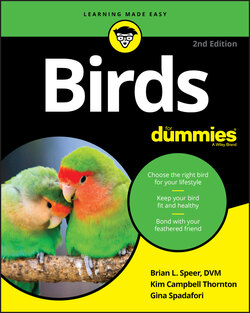Читать книгу Birds For Dummies - Gina Spadafori - Страница 100
Food as entertainment
ОглавлениеDon’t underestimate food as a way to keep your bird busy and amused. Check out puzzle toys designed to make eating a challenge. These challenging toys have skewers or nooks to hold foods such as fruits or nuts and are meant to make a game out of getting to these treats. One of our particular favorites is an acrylic tube you load up with favorite items, with holes to insert plain wooden pegs. To get the treats or toys out, the bird has to figure out how to pull the plugs. Ingenious!
Puzzle toys vary in complexity and may require birds to unscrew the toy, find food hidden in pockets or other compartments, lift flaps, or shake food out. Depending on the level of difficulty, you may have to help him learn how to successfully acquire the hidden delights. Break up training into small steps and be patient. You’ll be rewarded by your bird’s enjoyment when he figures out how to work the puzzle. Rotate different puzzles so he doesn’t get bored.
Look for these kinds of accessories in a good bird shop, at a bird show, or online.
Fortunately, toys are fun — to buy, to give to your bird, and to watch her enjoy. Knock yourself out, and know that your bird appreciates the effort. Try toys your bird can hold, toys that hang from the top and sides of the cage, and toys that also serve as perches, such as swings. Twirlies, holdies, chewies, puzzles, bright colors, and noisemakers all can keep your bird occupied.
Do you know the saying, “He who dies with the most toys wins”? Although a large number and variety of toys is important, you can go overboard — sort of. If your bird’s entire treasury of perches, dishes, and toys is stuffed in his cage, you may be limiting his movement and reducing his quality of life. Instead of giving your bird everything, get in the habit of rotating toys on a regular basis. Rotation every month or even every week not only reignites your bird’s interest but also helps you spot toys that need to be cleaned or replaced.
Toys come in an almost unimaginable array, and many are lovingly handmade. Some basic rules apply when shopping for toys to ensure they’re suitable for your bird and, of course, safe. Look for the following things when you’re in the market for toys:
Materials: Like perches, toys are subject to your bird’s destructive nature — and safety during demolition is a must. Wood, rawhide, plastic or steel chain, rope, cloth, and hard plastic are among the more popular construction materials. Be sure to choose toys that can break down without splintering or breaking into pieces small enough to be swallowed. (Clappers on bells, for example, often require removal. If you don’t remove them before giving a toy to your bird, your veterinarian may be removing them from his gullet.)
Construction: Challenging toys, the best choice for busy birds, feature pieces combined in ways that make it hard for birds to pull the whole product apart — but not too hard. Indestructible toys are not appropriate for most birds, because the fun of ripping the gadget apart is missing.
Size: Little toys for little birds, big toys for big birds. A big bird can catch and lose a toe in a toy made for a smaller bird, and small birds can get their heads trapped in toys made for larger relatives.
Connectors: If the toy isn’t already equipped with a connector, a simple key ring, available from any hardware store, is one way to attach the toy to the cage. Not all birds can safely have access to key rings, though. The larger the parrot, the greater the potential for them to pry it open and then injure themselves if their tongue or beak becomes trapped. Good ways to connect toys to cage bars include C-clamps and balls that rest on top of the cage with a hook hanging down for attaching a toy. You can also tie toys in place with pieces of rope or rawhide, but they won’t stay put very long.
What toy is bound to light up your bird’s face? Unfortunately, no clear-cut answer exists. Toys are a trial-and-error endeavor, a matter of individual preference where only your bird has a vote. Watch your bird. Look for trends in the kind of toys she prefers; those clues can guide you when you’re shopping for new ones.
